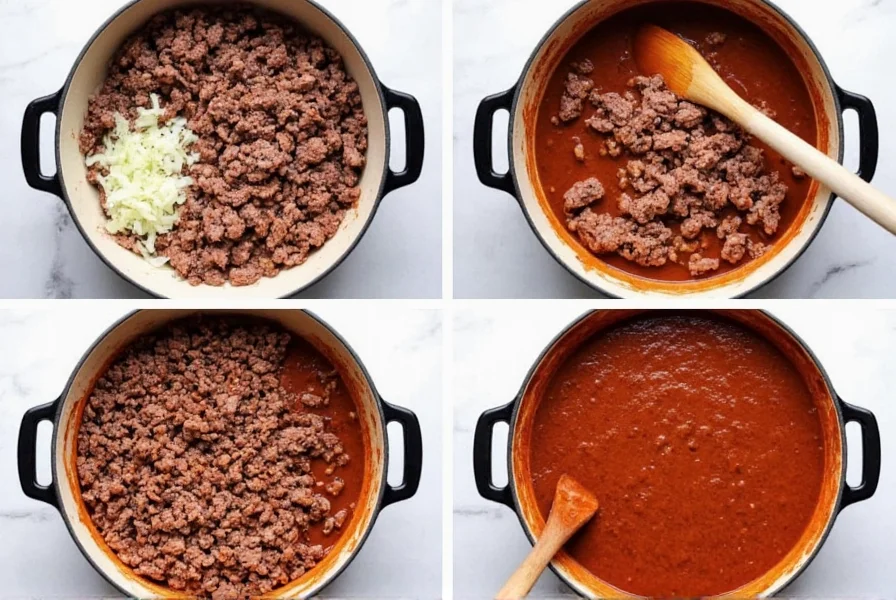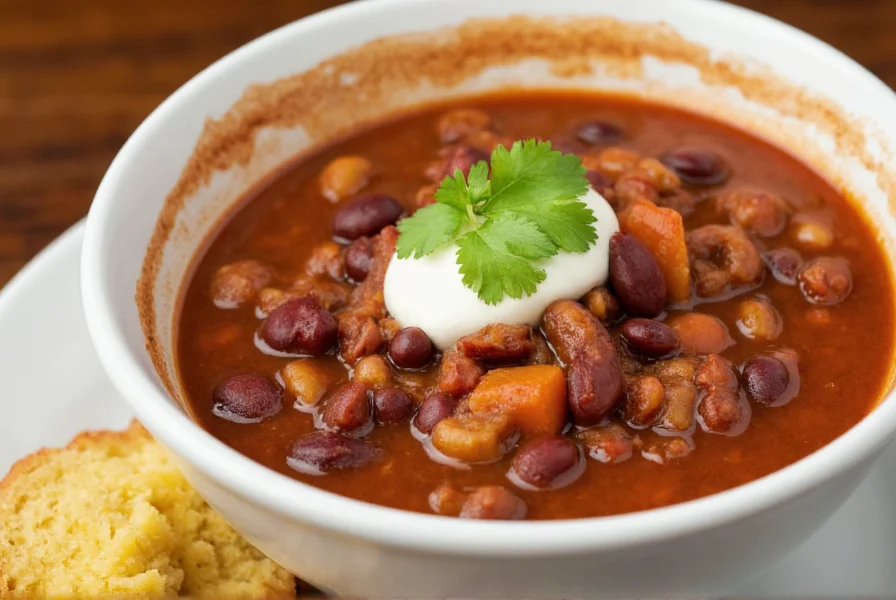The best chili with beans recipe combines ground beef, kidney beans, tomatoes, and spices simmered for 45-60 minutes. This easy homemade chili with beans serves 6-8 people and delivers rich, complex flavors through proper layering of ingredients and controlled simmering time. Authentic chili with beans requires no fancy equipment—just a heavy pot, quality spices, and patience for the flavors to develop.
Chili con carne with beans represents one of America's most beloved comfort foods, evolving from its Texas roots to become a versatile dish enjoyed nationwide. While traditional Texas chili often omits beans, most home cooks prefer the heartiness and texture that kidney beans, pinto beans, or black beans provide. This comprehensive guide delivers a foolproof chili with beans recipe perfected through decades of kitchen experience.
Why This Chili With Beans Recipe Works
Unlike rushed versions that compromise flavor, this method builds depth through three critical techniques: properly browning the meat to create fond, toasting spices before adding liquids, and allowing sufficient simmering time for flavors to meld. The result is a rich, complex chili with beans that avoids common pitfalls like blandness or mushy beans.
Essential Ingredients for Perfect Chili
The quality of your ingredients directly impacts the final dish. Here's what you'll need for authentic chili with beans:
| Ingredient | Quantity | Key Notes |
|---|---|---|
| Ground beef (80% lean) | 2 lbs | Use freshly ground chuck for best flavor |
| Onion, diced | 1 large | Yellow onions provide ideal sweetness |
| Garlic, minced | 4 cloves | Fresh is essential—no powder substitutes |
| Tomato paste | 3 oz | Concentrates flavor without excess liquid |
| Canned kidney beans | 2 (15oz) cans | Rinse thoroughly to remove excess sodium |
| Crushed tomatoes | 1 (28oz) can | San Marzano variety preferred |
| Beef broth | 2 cups | Low-sodium for better control |
| Chili powder | 3 tbsp | Freshly ground preferred |
| Cumin | 2 tsp | Toasted before use |
| Oregano | 1 tsp | Mexican variety if available |

Equipment Checklist
While you can make chili with basic kitchen tools, these items ensure optimal results:
- 6-quart heavy-bottomed pot or Dutch oven (essential for even heating)
- Wooden spoon for stirring
- Can opener
- Measuring cups and spoons
- Colander for rinsing beans
Step-by-Step Cooking Instructions
Step 1: Brown the Meat Properly
Break the ground beef into small chunks in your pot over medium-high heat. Resist stirring for 3-4 minutes to allow proper browning, which creates flavorful fond on the pot's bottom. Once browned, remove excess fat but retain about 2 tablespoons for cooking vegetables.
Step 2: Build Flavor Foundations
Add diced onions and cook until translucent (5-7 minutes). Stir in minced garlic and cook for 1 minute until fragrant. Push vegetables to the side and add tomato paste, cooking until it darkens slightly (2-3 minutes).
Step 3: Toast the Spices
Add chili powder, cumin, and oregano directly to the tomato paste mixture. Stir constantly for 1 minute to toast the spices—this critical step unlocks their full flavor potential and eliminates any raw taste.
Step 4: Simmer to Perfection
Pour in crushed tomatoes and beef broth, scraping the fond from the pot's bottom. Bring to a gentle simmer (not a rolling boil), then add rinsed beans. Partially cover and maintain a low simmer for 45-60 minutes, stirring occasionally. The chili is ready when the liquid has thickened and the flavors have melded.

Pro Tips for the Best Chili With Beans
- Bean timing matters: Add beans during the last 30 minutes of cooking to prevent them from becoming mushy
- Acid balance: Stir in 1 tablespoon of apple cider vinegar at the end to brighten flavors
- Texture control: Mash a small portion of beans against the pot's side to naturally thicken the chili
- Flavor development: Chili tastes better the next day—make it ahead when possible
Serving Suggestions
Serve your homemade chili with beans in wide, shallow bowls to maximize surface area for toppings. Traditional accompaniments include:
- Freshly grated cheddar or Monterey Jack cheese
- Sour cream or Greek yogurt
- Chopped fresh cilantro
- Lime wedges for a bright finish
- Warm cornbread or saltine crackers
Storage and Reheating Instructions
Proper storage maintains your chili with beans recipe's quality:
- Refrigeration: Store in airtight container for up to 5 days
- Freezing: Portion into freezer bags (lay flat for space efficiency) for up to 6 months
- Reheating: Warm gently on stove over medium-low heat, adding small amounts of broth if needed
Delicious Variations
Adapt this basic chili with beans recipe to suit different preferences:
Slow Cooker Method
After browning meat and toasting spices, transfer everything to a slow cooker and cook on low for 6-8 hours. Add beans during the last 2 hours.
Vegetarian Chili With Beans
Substitute beef with 2 cups cooked lentils and 1 cup chopped mushrooms. Use vegetable broth instead of beef broth, and add 1 cup corn kernels for texture.
Spice Level Adjustments
- Mild: Reduce chili powder to 2 tablespoons and omit cayenne
- Medium: Keep recipe as written
- Hot: Add 1-2 diced jalapeños with onions and 1/4 teaspoon cayenne
Frequently Asked Questions
What type of beans work best in chili with beans?
Kidney beans remain the classic choice for chili with beans recipe due to their hearty texture that holds up during simmering. Pinto beans offer a creamier texture, while black beans provide earthier notes. Many cooks combine two varieties for complexity—try 1 can kidney beans and 1 can pinto beans for balanced texture and flavor.
How can I thicken my chili with beans if it's too thin?
The best method to thicken chili with beans without compromising flavor is to create a slurry: mix 2 tablespoons cornstarch with 1/4 cup cold water, then stir into simmering chili. Alternatively, remove 1-2 cups of chili, blend until smooth, and return to the pot. Never boil vigorously to reduce liquid, as this can overcook the beans and make meat tough.
Can I make chili with beans in an Instant Pot?
Yes, you can make excellent chili with beans in an Instant Pot. Use the sauté function to brown meat and cook vegetables, then add remaining ingredients (except beans). Pressure cook on high for 10 minutes, followed by a natural pressure release. Stir in rinsed beans and use sauté function to simmer uncovered for 5-10 minutes to thicken. This quick chili with beans recipe method cuts cooking time significantly while maintaining flavor depth.
Why does my chili with beans taste bland?
Bland chili with beans typically results from three common mistakes: not properly browning the meat, failing to toast the spices, or insufficient simmering time. Always brown meat in batches to create fond, toast spices for 1 minute before adding liquids, and allow at least 45 minutes of gentle simmering. If your chili still lacks flavor, try adding 1 tablespoon of apple cider vinegar or a small pinch of cocoa powder to enhance depth without making the chili taste sweet or vinegary.











 浙公网安备
33010002000092号
浙公网安备
33010002000092号 浙B2-20120091-4
浙B2-20120091-4